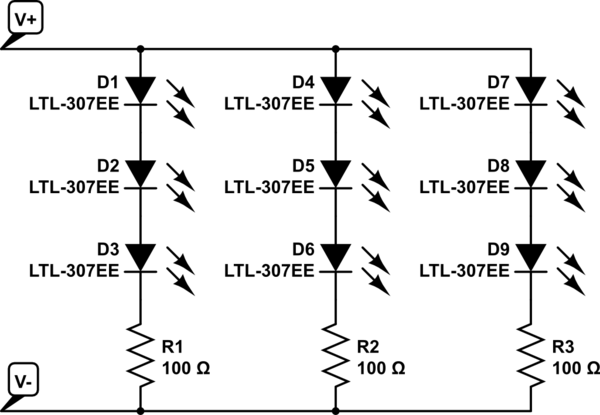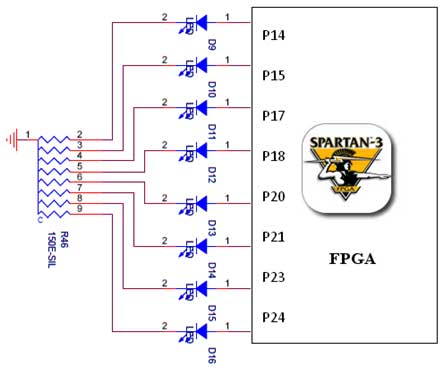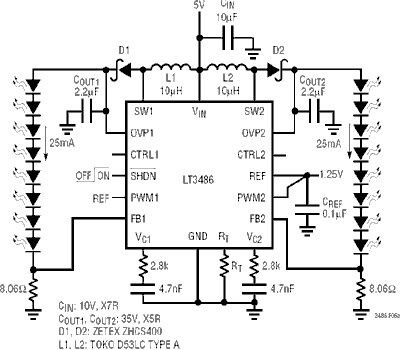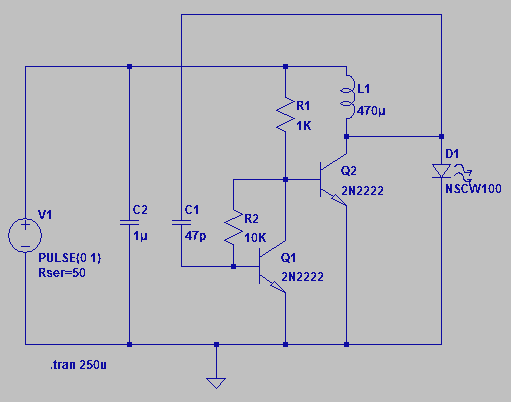
resistors calculating resistance for LED strips to use as parking lamps and turn signals

The project involves installing LED strips in a car's tail lamps to replace conventional bulbs. The required lengths for the LED strips are 16 inches, 15 inches, and 14 inches to fit properly within the housings. The selected LED strips measure 19.7 inches and contain approximately 1.5 LEDs per inch, necessitating segmentation into groups of three LEDs for optimal placement. It is understood that two diodes and a resistor are needed for the installation. One diode will be connected to the parking lamp power, and the other will be connected to the turn signal/brake power. A resistor will be placed on the parking lamp wire to reduce the voltage sufficiently, allowing the LEDs to function as parking lamps while ensuring they remain distinguishable from the brighter turn/brake lamps. The operating voltage at the rear lamps, when the vehicle is running, is approximately 13.8V, and it is estimated that the LEDs should be powered at around 7V to function effectively as parking lamps.
The installation of LED strips in automotive tail lamps presents a modern solution to enhance visibility and aesthetics. The LED strips, chosen for their length and density, will be cut into segments to create three-LED groups. This segmentation is crucial for maintaining uniform brightness and ensuring that the LED strips fit seamlessly within the existing housings.
The circuit design requires careful consideration of voltage and current to ensure the LEDs operate within their specified limits. The use of two diodes serves a dual purpose: one diode will protect the circuit from reverse polarity on the parking lamp line, while the second diode will do the same for the turn signal/brake line. Selecting the appropriate diodes is essential; typically, 1N4001 or similar silicon diodes rated for at least 1A and 50V will suffice for automotive applications.
The resistor in the circuit is critical for reducing the voltage supplied to the LEDs to approximately 7V. To calculate the resistor value, the following formula can be used:
\[ R = \frac{(V_{supply} - V_{LED})}{I_{LED}} \]
Where:
- \( V_{supply} \) is 13.8V,
- \( V_{LED} \) is the forward voltage drop of the LED (usually around 2V for standard LEDs),
- \( I_{LED} \) is the desired current through the LED (typically between 20mA to 30mA).
For example, if the forward voltage drop of the LED is 2V and the desired current is 20mA (0.020A), the calculation would be as follows:
\[ R = \frac{(13.8V - 2V)}{0.020A} = \frac{11.8V}{0.020A} = 590 \Omega \]
A standard resistor value of 560Ω or 620Ω could be used, depending on availability and desired brightness.
In summary, this project involves a systematic approach to converting conventional tail lamps to LED technology, ensuring that proper components are selected to achieve the desired functionality while maintaining safety and efficiency in the automotive electrical system.Installing LED strips in car`s tail lamps to convert it from conventional bulbs to LEDs. This is the product I`m planning on working with and I need a length of 16", 15" and 14" to make then look correct in my housings. When I did the math the 19. 7" strips have about 1. 5 LEDs per inch and need to be segmented into 3 LED groups so I may have to get creative with the placement.
Ffom what I understand I need 2 diodes and a resistor. One diode on the parking lamp power, and one on the turn signal/brake power and then a resistor on the parking lamp wire to step down the voltage enough to make them dim enough to use as a parking lamp and distinguish it from the brighter turn/brake lamps. Does anyone know what size resistor and what size diode to use in this project The voltage, with the car running, is around 13.
8V to the rear lamps. I figure it should be running around 7V to the LEDs to light them as parking lamps. 🔗 External reference
The installation of LED strips in automotive tail lamps presents a modern solution to enhance visibility and aesthetics. The LED strips, chosen for their length and density, will be cut into segments to create three-LED groups. This segmentation is crucial for maintaining uniform brightness and ensuring that the LED strips fit seamlessly within the existing housings.
The circuit design requires careful consideration of voltage and current to ensure the LEDs operate within their specified limits. The use of two diodes serves a dual purpose: one diode will protect the circuit from reverse polarity on the parking lamp line, while the second diode will do the same for the turn signal/brake line. Selecting the appropriate diodes is essential; typically, 1N4001 or similar silicon diodes rated for at least 1A and 50V will suffice for automotive applications.
The resistor in the circuit is critical for reducing the voltage supplied to the LEDs to approximately 7V. To calculate the resistor value, the following formula can be used:
\[ R = \frac{(V_{supply} - V_{LED})}{I_{LED}} \]
Where:
- \( V_{supply} \) is 13.8V,
- \( V_{LED} \) is the forward voltage drop of the LED (usually around 2V for standard LEDs),
- \( I_{LED} \) is the desired current through the LED (typically between 20mA to 30mA).
For example, if the forward voltage drop of the LED is 2V and the desired current is 20mA (0.020A), the calculation would be as follows:
\[ R = \frac{(13.8V - 2V)}{0.020A} = \frac{11.8V}{0.020A} = 590 \Omega \]
A standard resistor value of 560Ω or 620Ω could be used, depending on availability and desired brightness.
In summary, this project involves a systematic approach to converting conventional tail lamps to LED technology, ensuring that proper components are selected to achieve the desired functionality while maintaining safety and efficiency in the automotive electrical system.Installing LED strips in car`s tail lamps to convert it from conventional bulbs to LEDs. This is the product I`m planning on working with and I need a length of 16", 15" and 14" to make then look correct in my housings. When I did the math the 19. 7" strips have about 1. 5 LEDs per inch and need to be segmented into 3 LED groups so I may have to get creative with the placement.
Ffom what I understand I need 2 diodes and a resistor. One diode on the parking lamp power, and one on the turn signal/brake power and then a resistor on the parking lamp wire to step down the voltage enough to make them dim enough to use as a parking lamp and distinguish it from the brighter turn/brake lamps. Does anyone know what size resistor and what size diode to use in this project The voltage, with the car running, is around 13.
8V to the rear lamps. I figure it should be running around 7V to the LEDs to light them as parking lamps. 🔗 External reference





